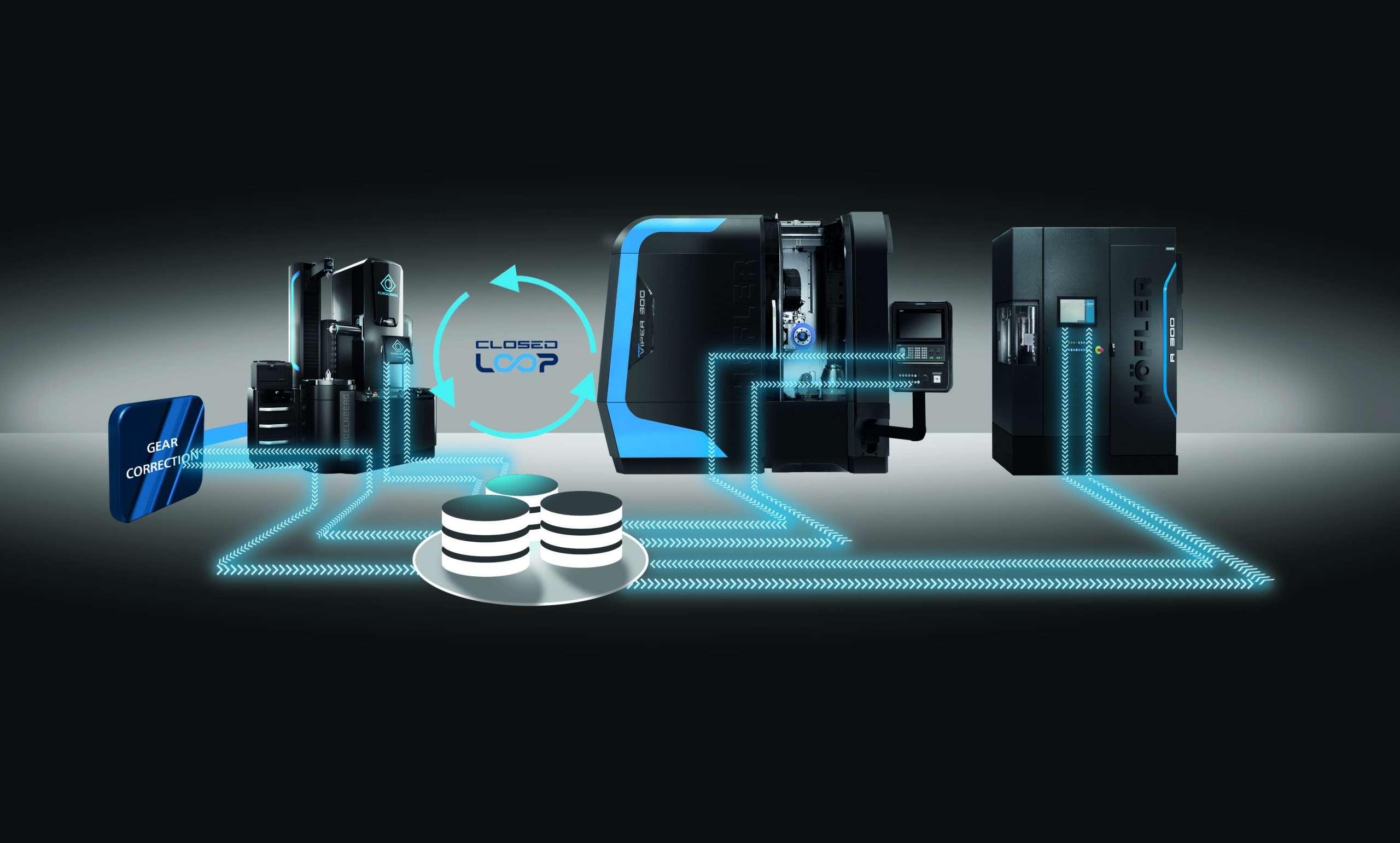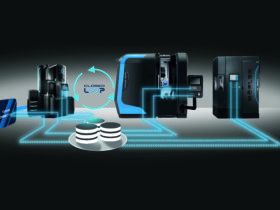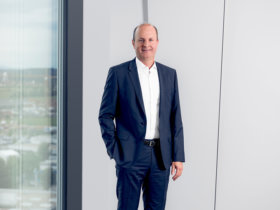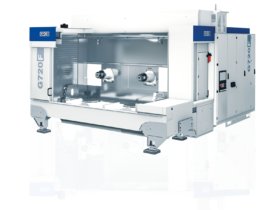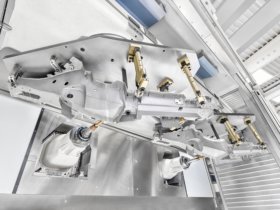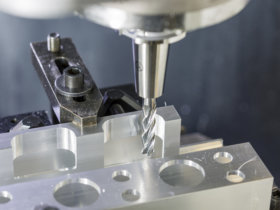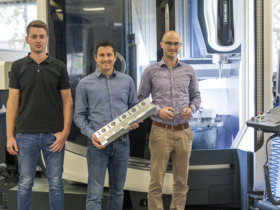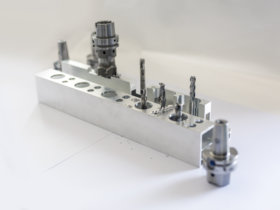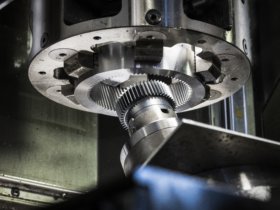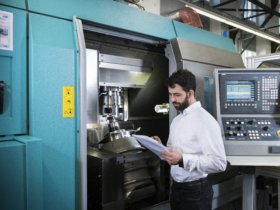E-mobility electrifying the EMO Hannover 2023
Electromobility will be the top topic at EMO Hannover 2023. Insights will be provided by renowned manufacturers and research experts.
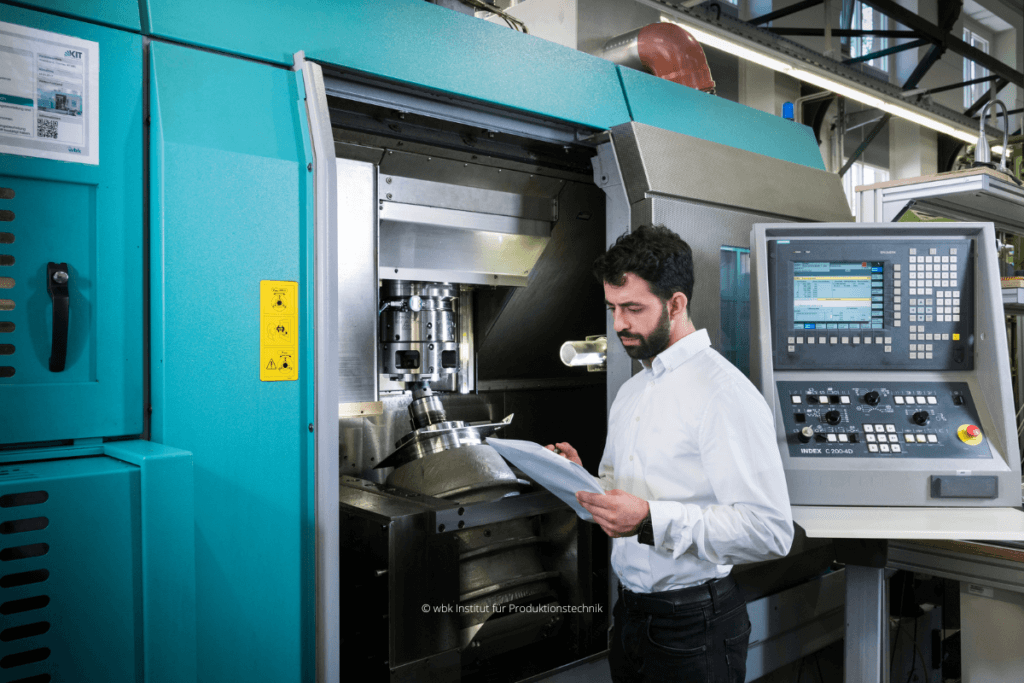
How can manufacturing technology promote e-mobility?
The automotive industry is consistently pushing forward electromobility. This, in turn, has implications for manufacturing technology. More and more intricate and lightweight parts need to be processed. What is the most economical way to machine battery components? What challenges are involved in gear and transmission manufacturing? These and other questions will be some of the key issues at EMO Hannover 2023. Answers will be provided by machine tool and tooling manufacturers, and by researchers.
Quiet gearing for electric vehicles
Gear noise is a key quality feature in transmissions for electrically driven vehicles. The relatively loud combustion engine’s days are numbered, and so the focus is now shifting to the amount of noise generated by the other drive components, with gears representing the greatest source. Klingelnberg GmbH from Hückeswagen has adapted its production system accordingly and is showcasing the result at EMO Hannover. The company’s primary focus is on gear grinding as well as quality assurance. “In gear grinding, Quiet Surface Shifting (QSS) provides an intelligent dressing and grinding strategy for breaking up the regular grinding structures on the gear surface, thus yielding improved noise behavior,” explains Dr. Christof Gorgels, Vice President Technology and Innovation at Klingelnberg. “The single flank rolling test in all its different forms facilitates realistic noise testing of gears within the grinding cycle.”
The deviation analysis conducted as part of the precision measurement also allows waviness to be evaluated as a regular element of the form error. This highlights noise-critical deviations on the tooth flank and allows corrective measures to be defined. Combining all three systems to form a closed loop allows close monitoring and correction of the manufacturing process. Here, the single flank rolling test provides full monitoring of the grinding process. “This allows noisy components to be detected immediately and then rejected and fed to the precision measurement,” adds Gorgels. “The measurement then quantifies the deviations. Ideally, the processing machine can then be automatically corrected as a direct result. The result is a short and fast control loop for quiet gearing.”
Crossover series for all major e-mobility components
Grob-Werke GmbH & Co. KG based in Mindelheim in Bavaria is known for its broad-based and differentiated portfolio of machines. For several years now, it has increasingly been aiming its products at manufacturers in the electromobility sector. This will also be the main focus on the company’s stand at EMO Hannover. “The development is not standing still, and the market is demanding equipment for the production of stators, rotors and batteries. But it also needs lightweight-construction battery trays, subframes, structural components and much more besides for e-drives,” explains Christian Müller, CSO and Member of the Board. This is why Grob is increasingly shifting the focus of its machining technology portfolio in this direction. The series are being optimized for electromobility and being completely redeveloped and launched on the market to meet customers’ changing needs. A current machine series represents a good example here: It has been developed for the lightweight manufacture of components for the e-drive. Single- and two-spindle machines are also being adapted accordingly. For 2023, new machine sizes are also scheduled which allow even larger components to be milled for the e-drive in a single operation. This Grob series now comprises five machine types, meaning that every customer is certain to find the right solution. “The machines have to include component-optimized workspaces and be dynamic and robust,” explains Müller. “In the coming years, there will be rising demands on cutting machines for e-drives and new solutions will have to be found. Grob responds quickly to changing requirements, with this series already meeting the specific needs of electromobility.”
A strategy for battery frames
The battery frame is a key component in every electrically powered vehicle. The electromobility experts at Mapal Fabrik für Präzisionswerkzeuge Dr. Kress KG in Aalen, Germany, have developed a generic process based on various customer components. It contains the main battery frame machining operations for a generic component. Major machining challenges include stepped bores, bores with different diameters through multiple layers, milled pockets with various dimensions, shoulders and, most importantly, vibration susceptibility due to thin rib structures and chip breakage control. “Mapal meets these challenges primarily using specially designed milling cutters. Even the majority of the bores on the frame component are milled,” reports Matthias Winter, Global Head of Segment Management Automotive. “The cycle time is somewhat longer if bores are milled, however the process offers distinct advantages in this specific case – short milling chips that can be easily removed, reduced burr formation, greater process reliability and no tool changes.”
The Baden-Württemberg-based company recommends the use of a special solid carbide cutter for roughing the shoulders, pockets and grooves and for finishing the pockets. This creates the best possible surfaces and works stably even in corners with large wrapping and high loads. A special feature of this tool is that users can finish greater depths in a single action. This saves time and is therefore particularly economical. Surfaces of down to Rz = 1 µm (average roughness depth) are achieved during battery frame finishing. A total of seven tools – including six milling cutters – are used in the entire generic process. “And so Mapal offers customers a complete package of polycrystalline diamond (PCD) and solid carbide tools, chucks and a corresponding process which meets the challenges of battery frame machining. Here, the specialists modify the generic process to match the individual circumstances,” concludes Matthias Winter.
Digitalization as an enabler of new transmission architectures
High-speed motors make it possible to produce low-volume yet high-powered electric motors. “However, such drives require a high gear ratio in order to yield the relatively low wheel speed. At the same time, the transmissions need to be even more efficient than before in order to prevent any negative impact on the vehicle’s range and the continuous output of the drive,” explains Prof. Dr.-Ing. Jürgen Fleischer, Director of Machines, Equipment and Process Automation at the wbk Institute of Production Science.
Transmission designs based on planetary sets meet these requirements. However, the cost-effective production of the required thin-walled internal gears and stepped planetary gears with close interference contour can be hampered by collisions between the workpiece and the tool. The gear skiving process developed through to series production readiness at the wbk Institute of Production Science permits highly productive and flexible manufacturing of such gears. Significant fluctuations arise in gear quality in large-scale industrial production, however, due to tool wear and inconsistencies between material batches. The lack of process data acquisition means that a wide range of options for correcting the gear geometry are currently largely unused. “However, the synergies arising from simulation-based soft sensor technology and machine-integrated edge computing allows any profile and flank deviations to be detected,” adds the institute director. Here, machining forces and tool center point displacement are calculated from the machine’s own data. Real-time remaining useful life prediction for gears can be used to forecast and correct the effect of machining forces on the manufactured gear quality. This can effectively compensate for the effects of tool wear and batch fluctuations in particular.
e-mobility is without question one of the current megatrends. Lightweight and in some cases intricate components as well as sophisticated materials need to be machined cost-effectively. The machine tools, precision tools and test methods used should basically be viewed as part of an overall process. The manufacturing processes used by leading suppliers are clearly outlined above. EMO 2023 Hannover offers an excellent platform for obtaining information on these and other manufacturing topics.
((Info box))
Precision testing technology
Klingelnberg is tracking noise sources with the aid of the R 300 roll testing machine – as can be seen in the interview with Dr. Alexander Landvogt on YouTube Interview mit Dr. Alexander Landvogt
The video is also available in English
Interview with Dr. Alexander Landvogt
((Info box))
Machines for e-mobility components
Grob describes the advantages of its current series of machines in a 2-minute video: GROB Product Stories – F-Series | F-Serie
((Info box))
Sophisticated gear manufacturing
How gear skiving is used as a manufacturing process for gear production is shown in an descriptive video: Gear production
Contacts
Grob-Werke GmbH & Co. KG
Christian Müller
CSO and Member of the Board
Industriestr. 4
87719 Mindelheim
Germany
Tel. +49 8261 996-0
Klingelnberg GmbH
Dr. Christof Gorgels
Vice President Technology and Innovation
Peterstr. 45
42499 Hückeswagen
Germany
Tel. +49 2192 81-0
christof.gorgels@klingelnberg.com
Mapal Fabrik für Präzisionswerkzeuge Dr. Kress KG
Matthias Winter
Global Head of Segment Management Automotive
Obere Bahnstr. 13
73431 Aalen
Germany
Tel. +49 7361 585-0
Karlsruhe Institute of Technology KIT
wbk Institute of Production Science
Prof. Dr.-Ing. Jürgen Fleischer
Director of Machines, Equipment and Process Automation
Kaiserstr. 12
76131 Karlsruhe
Germany
Tel. +49 721 608-44009


